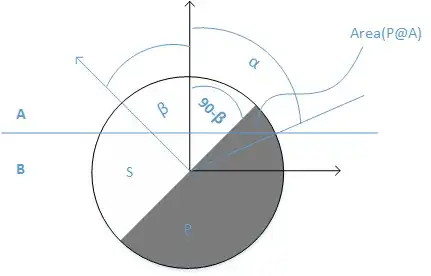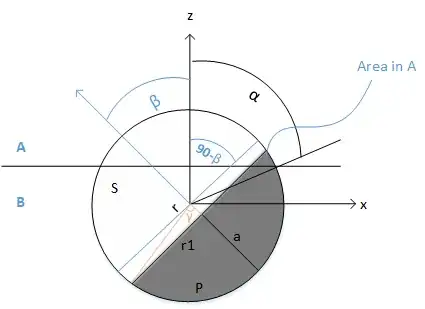I have a sphere with radius $r$ that equally divided in to two hemisphere P and S. There is a plane that separate two different zone A and B. Upper zone called A and lower zone called B. $\alpha$ is the contact angle. So $\alpha $ larger means sphere is more in zone A and vice versa. Range of $\alpha $ can go between $[0,\pi]$The angle $\beta$ defines the orientation of the sphere which is an angle between z axis (vertical) and a unit vector. Range of $\beta $ can be $[0,2\pi]$. The Schematic representation of this is below.
To calculate the area of $P$ portion of the sphere into $A$ is given by following equation $$ \mathrm{Area}_{P@A}= r^2\int_{\theta=\frac{\pi}{2}-\beta}^\alpha \int_{\phi=\arcsin(1/(\tan\theta \tan \beta))} ^{\pi -\arcsin(1/(\tan\theta \tan \beta)} \sin\theta\; d\theta d\phi. $$
After solving this equation we can get the following solution. $$ \textrm{Area}_{P@A}= 2 r^2 \left\{ \cos (\alpha) \sin ^{-1}(\cot (\alpha) \cot (\beta)) -\tan ^{-1}\left(\frac{\cos (\beta)}{\sqrt{\sin ^2(\beta)-\cos ^2(\alpha)}}\right)\right\}+\pi r^2 (1-\cos (\alpha)). $$
Note that the solution is defined as a function of $\alpha$ and $\beta$. If we change the value of $\alpha $ and $\beta$, the area of P into A will change eventually.
Now consider more complex case where $P$ and $S$ are not equal hemisphere.
Question: If $P$ and $S$ are not equal hemisphere rather they are spherical cap, then what I need to consider to calculate the area of $P$ into zone $A$ as a function of $\alpha$ and $\beta$? Here $\gamma$ defines size of the spherical cap and r1 is the radius of the base of the cap. Do I need to introduce any other parameter?
